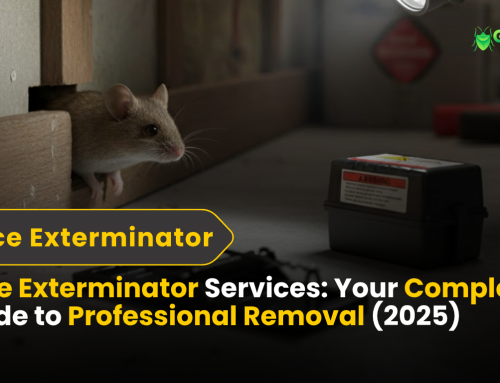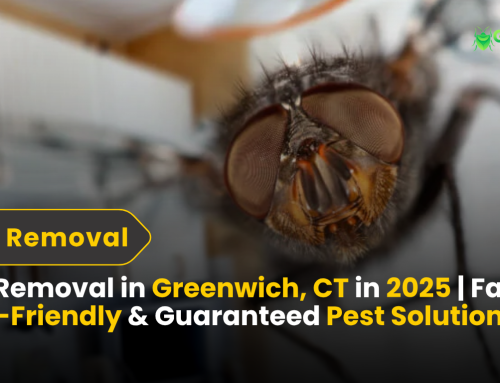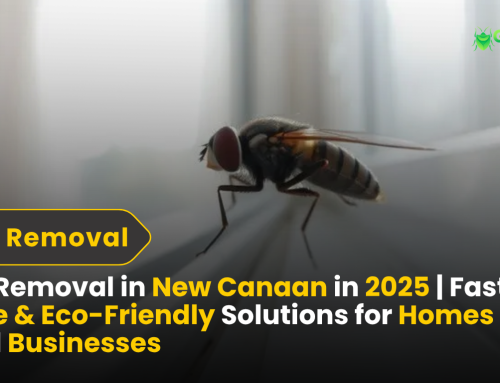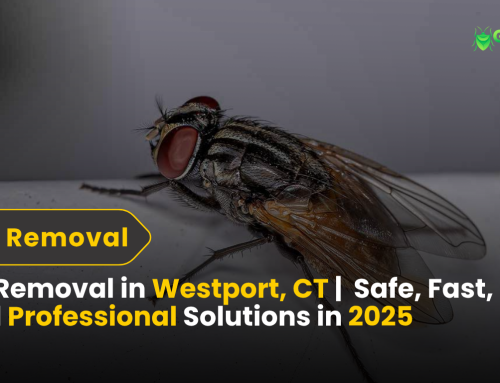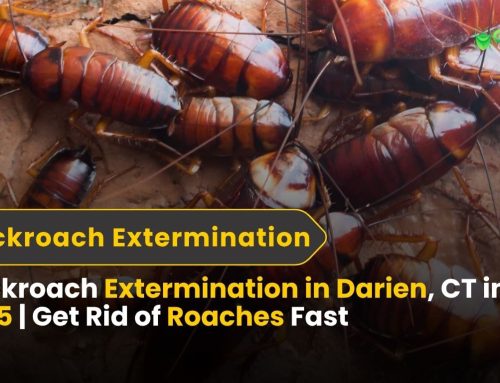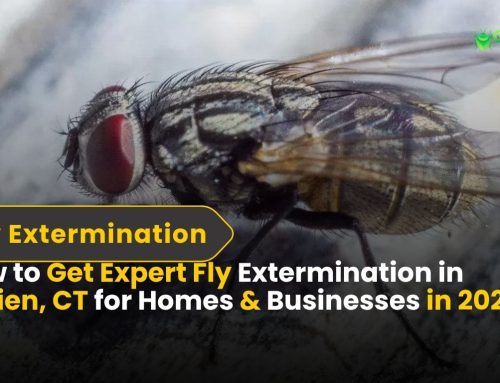Cockroach Exterminator Guide | Professional Removal & Prevention (2025)
Spotting a cockroach scuttling across your kitchen floor is more than just a moment of disgust—it’s a red flag for a potential health hazard in your home. These resilient pests are notorious for spreading bacteria and triggering allergies. If you’re seeing roaches, especially during the day, it often indicates a larger, hidden infestation. This comprehensive guide will walk you through everything you need to know about professional cockroach exterminator services, from the methods they use to the costs involved, empowering you to reclaim a healthy, roach-free home in Connecticut.
What Does a Cockroach Exterminator Do?
A professional cockroach exterminator is a trained specialist whose role is to be a detective, strategist, and executor. Their job goes far beyond a simple spray. They implement a systematic process designed to eliminate the entire population—those you see and the many more you don’t.
Thorough Property Inspection: Finding the Enemy
The foundation of effective roach control is a meticulous inspection. A certified technician will leave no stone unturned to understand the full scope of your problem.
-
Kitchen and Bathroom Focus: These areas provide the perfect trifecta for roaches: food, water, and shelter. Technicians will inspect under sinks, behind appliances, inside cabinets, and around plumbing fixtures.
-
Hidden Harborage Areas: Roaches are thigmotropic, meaning they prefer tight spaces. Your technician will use flashlights and mirrors to check behind electrical outlets, in void spaces under drawers, within motor compartments of refrigerators, and in the folds of cardboard boxes.
-
Entry Point Identification: The inspection also involves identifying how roaches are getting in, from gaps around pipes and utility lines to cracks in the foundation or through infested packages.
Roach Species Identification: The Key to Success
Correctly identifying the cockroach species is critical because different roaches require different treatment strategies. Here are the most common invaders in Connecticut homes:
-
German Cockroaches: The most common and problematic indoor species. They are small, light brown with two dark stripes behind the head, reproduce rapidly, and are typically found in kitchens and bathrooms.
-
American Cockroaches: Often called “water bugs,” these are large, reddish-brown roaches that can fly. They often invade from sewer systems or mulch beds and prefer damp, cool areas like basements and crawl spaces.
-
Oriental Cockroaches: Dark brown or black, shiny roaches. They have a strong preference for decaying organic matter and are often found in damp basements, floor drains, and under leaf litter around the foundation.
-
Brown-Banded Cockroaches: Similar in size to German roaches but with lighter bands across their wings. They tend to scatter throughout a home, nesting in warmer, drier areas like ceilings, behind picture frames, and inside electronics.
Customized Treatment Plan Development
There is no universal solution for cockroach control. Based on the inspection and species identification, the exterminator will develop a tailored plan. This plan considers the infestation’s severity, the specific biology of the roach, and the unique layout of your home.
Professional Treatment Methods
Professionals have access to a powerful arsenal of tools and the expertise to use them strategically.
-
Gel Baiting: This is often the primary weapon. Attractive gel baits are placed in tiny dabs in harborage areas. Roaches feed on the bait and return to their nest, where they die and are cannibalized by others, spreading the poison throughout the colony.
-
Insecticide Sprays: Residual insecticide sprays are applied to baseboards, cracks, and crevices. These create a long-lasting barrier that kills roaches upon contact for weeks after the application.
-
Dust Applications: Insecticidal dusts are blown into wall voids, electrical outlets, and other inaccessible spaces where sprays can’t reach. The dust clings to the roaches’ bodies, ensuring they carry the poison back to their nest.
-
IGR (Insect Growth Regulators): These are “birth control” for roaches. IGRs disrupt the roaches’ life cycle, preventing nymphs from maturing into breeding adults and rendering eggs non-viable. They are a crucial component for long-term control.
-
Heat Treatment: For severe, pervasive infestations, professionals may use specialized equipment to raise the temperature of a room or entire structure to a level lethal to all life stages of cockroaches, including eggs.
How to Exterminate Cockroaches: The Professional 6-Step Process
Understanding the systematic approach used by professionals can set realistic expectations and demonstrate why their methods are so effective.
Step 1: Comprehensive Inspection & Assessment
The technician performs the detailed inspection outlined above, mapping out harborage sites and identifying the primary species.
Step 2: Species-Specific Treatment Selection
The treatment plan is finalized, selecting the right combination of baits, sprays, dusts, and IGRs to target the specific roach species in your home.
Step 3: Initial Treatment Application
The technician executes the plan, applying products to all identified harborage areas and entry points. This is a precise, targeted process, not a general spraying.
Step 4: Scheduled Follow-Up Treatments
Especially for German cockroaches, a single treatment is rarely enough. The exterminator will schedule a follow-up visit in 2-3 weeks to assess the bait consumption, apply new treatments, and address any newly hatched nymphs.
Step 5: Ongoing Monitoring & Evaluation
The technician will use sticky traps to monitor population levels and ensure the treatment is working effectively, making adjustments as needed.
Step 6: Detailed Prevention Recommendations
You will receive a customized list of actions to take, such as sealing cracks, fixing leaks, and improving sanitation, to prevent a recurrence.
Cockroach Extermination Methods Compared
A professional cockroach exterminator has multiple tools at their disposal. Here’s a breakdown of the most common ones.
Gel Bait Treatment
-
How it Works: A slow-acting poison is mixed with an attractive food source. Roaches ingest it and die later, poisoning others in the nest through cannibalism and fecal matter.
-
Pros: Highly effective, targets the entire colony, low visibility, minimal odor.
-
Cons: Can be less effective if competing food sources are abundant.
-
Best For: German and Brown-Banded cockroaches.
Residual Spray Applications
-
How it Works: A long-lasting insecticide is applied to surfaces where roaches travel. It remains active for weeks, killing roaches on contact.
-
Pros: Creates a protective barrier, immediate knock-down effect.
-
Cons: Can have a stronger odor, requires more preparation from the homeowner.
-
Best For: Perimeter defense and treating large, open areas where American or Oriental roaches may travel.
Dust Insecticides
-
How it Works: A fine, dry powder is applied to void spaces where it adheres to roaches’ bodies.
-
Pros: Excellent for wall voids and electrical outlets, long-lasting.
-
Cons: Requires professional application to avoid creating airborne particles.
-
Best For: Supplementing other treatments in inaccessible areas.
Heat Treatment
-
How it Works: Specialized heaters raise the air temperature in a contained area to 120-140°F for several hours, killing all roaches and eggs.
-
Pros: Chemical-free, 100% effective in the treated area, single-session solution.
-
Cons: Very expensive, requires extensive preparation, risk of damage to heat-sensitive items.
-
Best For: Severe, widespread infestations that have proven resistant to chemical treatments.
Fumigation
-
How it Works: The entire structure is tented and filled with a lethal gas.
-
Pros: Penetrates every crack and crevice, guaranteed elimination.
-
Cons: Extremely expensive, requires occupants and pets to vacate for several days.
-
Best For: Extreme, whole-structure infestations, typically in commercial settings.
| Method | How It Works | Best For | |
|---|---|---|---|
| Gel Baiting | Secondary poisoning via cannibalism | German & Brown-Banded Roaches | |
| Residual Spray | Contact killer; creates a barrier | American & Oriental Roaches | |
| Insecticidal Dust | Clings to bodies in void spaces | Supplementing other methods | |
| Heat Treatment | Lethal temperatures | Severe, resistant infestations | |
| Fumigation | Gas penetrates entire structure | Extreme whole-house infestations |
German Cockroach Extermination: A Special Focus
German cockroaches are the most challenging species to eliminate. They reproduce at an astonishing rate, with one female capable of producing hundreds of offspring in her lifetime. They also develop resistance to insecticides quickly.
-
Specialized Treatment Protocols: Eradicating them requires a multi-pronged attack: precise gel bait placement, the use of IGRs to break the reproductive cycle, and dusts in wall voids.
-
Timeline to Elimination: Due to their reproductive cycle, eliminating a German roach infestation typically requires 2-3 professional treatments over 4-8 weeks.
-
Prevention After Treatment: Meticulous sanitation and ongoing monitoring are non-negotiable to prevent a resurgence.
Cockroach Exterminator Cost Guide
Understanding the investment helps you make an informed decision.
Average Costs by Treatment Type
-
One-Time Treatment: Suitable for minor infestations of American or Oriental roaches.
-
Initial Service + Follow-ups (for Germans): This is the most common scenario for German roach control.
-
Severe Infestation (Heat/Fumigation): For pervasive problems requiring extreme measures.
-
Quarterly Preventive Service: Often part of a broader pest control plan.
Cost by Roach Species
German cockroaches are the most expensive to treat due to the labor and multiple visits required. American and Oriental roach treatments are generally less costly.
How to Find the Best Cockroach Exterminator
Choosing the right professional is the most important step.
-
Qualifications to Look For: Ensure the company is licensed and insured in Connecticut. Technicians should be certified by organizations like the state DEEP.
-
Experience with Roach Species: Ask specifically about their success rate and protocol for German cockroaches if that’s your problem.
-
Treatment Approach: Avoid companies that only “spray and pray.” The best cockroach exterminator will explain a detailed IPM-based plan involving baits and IGRs.
-
Warranty & Service Guarantees: A reputable company will offer a 30-90 day warranty, promising to return for free if the problem persists.
-
Customer Reviews: Check Google and BBB for reviews that specifically mention roach control.
-
Green/Eco-Friendly Options: If this is important to you, ask about baiting and IGR-based strategies, which are inherently lower-impact.
Signs You Need a Professional Cockroach Exterminator
Don’t wait until you see an army of roaches. Look for these telltale signs:
-
Visual Signs:
-
Live Roaches: Seeing them during the day is a major red flag.
-
Droppings: Resemble coffee grounds or black pepper.
-
Egg Casings (Oothecae): Small, brown, pill-shaped capsules.
-
Shed Skins: Pale, shell-like skins left behind as nymphs grow.
-
-
Smell Indicators: A strong, musty, oily odor that lingers in severe infestations.
-
Damage Signs: Gnaw marks on food packaging or book bindings.
-
When DIY Has Failed: If store-bought traps and sprays haven’t made a dent after two weeks, the infestation is likely beyond DIY control.
How Long Does Cockroach Extermination Take?
Patience is key. A professional treatment doesn’t work like a bug bomb.
-
Minor Infestation: You should see a significant reduction within 1-3 days, with full control in 1-2 weeks.
-
German Cockroach Infestation: It can take 2-3 treatments over 4-8 weeks to achieve complete elimination due to their reproductive cycle and the time it takes for baits to work through the colony.
-
What Affects Duration: The species, infestation size, and level of homeowner cooperation (sanitation, preparation) all impact the timeline.
Cockroach Extermination Safety
A common and valid concern for homeowners.
-
Pet Safety: Most modern baits and IGRs have low toxicity to mammals. However, pets should be kept away from treated areas until sprays have dried (typically 2-4 hours). Always inform your technician about your pets.
-
Child Safety Precautions: The same re-entry times apply. Technicians will place baits in areas inaccessible to children, such as under appliances and inside cracks.
-
Food Preparation Areas: All food contact surfaces should be covered or thoroughly washed after treatment. All food should be stored in sealed containers.
-
Re-Entry Timeframes: For spray applications, a 2-4 hour ventilation period is standard before re-entering the home.
Preparing for Cockroach Extermination: A Checklist
Your preparation is critical to the treatment’s success.
-
Kitchen:
-
Empty all cabinets and drawers.
-
Remove everything from countertops.
-
Pull large appliances (stove, refrigerator) away from the wall.
-
Secure all food, pet food, and dishes in sealed containers.
-
-
Bathroom:
-
Empty all vanity cabinets.
-
Remove items from around the tub and toilet.
-
-
Living Areas:
-
Vacuum all floors, especially in corners and under furniture.
-
Reduce clutter, especially stacks of paper and cardboard.
-
Pick up pet food and water bowls.
-
After Extermination: What to Expect
-
Initial Increase in Activity: Don’t be alarmed! It’s common to see more roaches in the open for the first 1-3 days after treatment. This is because the pesticides are flushing them out of their harborage sites as they become affected.
-
Dead Roach Cleanup: You will need to vacuum and clean up dead roaches as they appear. This helps remove egg casings and allergens.
-
Follow-Up Treatments: Adhere strictly to the schedule. Skipping a follow-up is the number one reason German roach treatments fail.
-
How to Know It’s Working: The ultimate sign of success is the complete absence of live roaches, new droppings, or the musty odor over a period of several weeks.
Cockroach Exterminator vs. DIY
| Factor | DIY Approach | Professional Exterminator |
|---|---|---|
| Success Rate | Low for established infestations | Very High |
| Time Investment | High and ongoing | Hands-off for the homeowner |
| Safety | Risk of misapplication | Professional, targeted application |
| Long-Term Results | Temporary relief at best | Long-lasting, often guaranteed |
When DIY is appropriate: For a single, stray American cockroach that wandered in from outside.
When you MUST call a pro: For any sighting of German cockroaches, or any recurring activity of other species.
Apartment Cockroach Extermination
In multi-unit buildings, roaches easily travel between units.
-
Tenant Rights: In Connecticut, landlords are generally responsible for providing a habitable, pest-free premises.
-
Landlord Obligations: They are required to address infestations promptly. Report the issue in writing.
-
Whole Building Treatment Necessity: For German roaches, treating a single unit is often futile. Effective control requires a coordinated effort across adjacent units.
-
Cost Responsibility: Typically, the landlord bears the cost of extermination for a multi-unit infestation.
Natural vs. Chemical Extermination
-
Natural Remedies Effectiveness: DIY solutions like boric acid, diatomaceous earth, and essential oils can kill individual roaches but are rarely effective at eliminating an entire colony. They lack the potency and transfer effect of professional products.
-
When Chemicals are Necessary: For any established infestation, professional-grade baits and IGRs are necessary for complete eradication.
-
Eco-Friendly Professional Options: Many professionals offer “green” solutions that prioritize baits, dusts, and IGRs—which are highly targeted and have low environmental impact—over broad-spectrum sprays.
-
Integrated Pest Management (IPM): This is the gold standard. It combines multiple strategies—sanitation, exclusion, monitoring, and the judicious use of chemicals as a last resort—for sustainable, long-term control.
Frequently Asked Questions (FAQ)
Q1: How long does it take to get rid of cockroaches?
A: For a minor issue, 1-2 weeks. For a German cockroach infestation, a complete solution typically takes 4-8 weeks with multiple treatments.
Q2: Is the treatment safe for my pets?
A: When applied by a licensed professional, yes. They use products with low mammalian toxicity and will provide specific instructions, like keeping pets away until sprays have dried.
Q3: Why am I seeing more roaches after treatment?
A: This is normal and actually a sign the treatment is working. The pesticides are agitating the roaches and forcing them out of their hiding spots before they die.
Q4: Can one cockroach lead to an infestation?
A: If that one cockroach is a pregnant female, absolutely. A single German cockroach egg case can contain 30-40 eggs. It’s always best to investigate any sighting.
Q5: What is the most effective way to kill cockroaches?
A: Professional gel baiting combined with Insect Growth Regulators (IGRs) is widely considered the most effective method for eliminating an entire colony.
Q6: How can I prevent cockroaches from coming back?
A: The key is to eliminate their resources: store food in sealed containers, fix leaky faucets, seal cracks and crevices, and reduce clutter where they can hide.
Q7: Are the chemicals used by exterminators safe for my family?
A: Licensed professionals use EPA-approved products according to strict label instructions. While all pesticides carry some risk, the application methods (e.g., crack and crevice treatment) and modern chemistries make them safe for home use when applied correctly.
Conclusion: Don’t Live with the Health Risks
Cockroaches are more than a nuisance; they are a threat to your home’s hygiene and your family’s health. While the sight of them can be discouraging, a professional cockroach exterminator has the knowledge, tools, and systematic process to eliminate them completely.
By understanding the methods, costs, and what to look for in a professional, you can take confident action. If you’re in Connecticut and suspect a roach problem, don’t hesitate.
Contact Green Pest Management CT today for a thorough inspection and a customized plan to reclaim your roach-free home.
Recent Posts
- Cockroach Exterminator Guide | Professional Removal & Prevention (2025)
- Mice Exterminator Services | Your Complete Guide to Professional Removal (2025)
- Fly Removal in Greenwich, CT in 2025 | Fast, Eco-Friendly & Guaranteed Pest Solutions
- Fly Removal in New Canaan in 2025 | Fast, Safe & Eco-Friendly Solutions for Homes and Businesses
- Fly Removal in Westport, CT | Safe, Fast, and Professional Solutions in 2025

